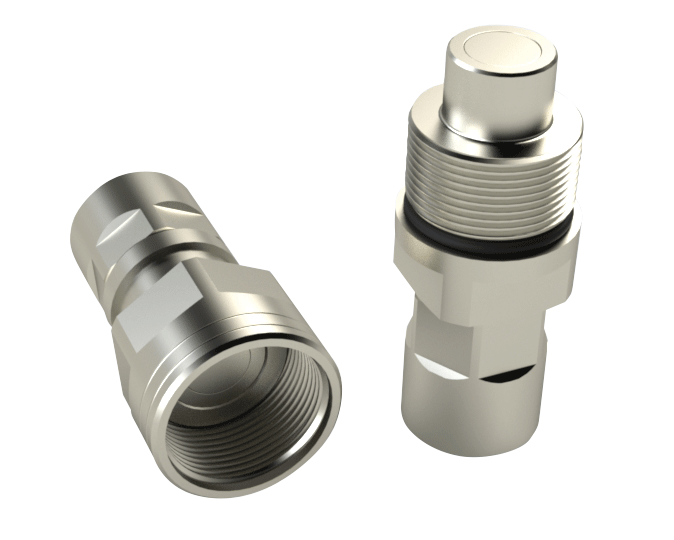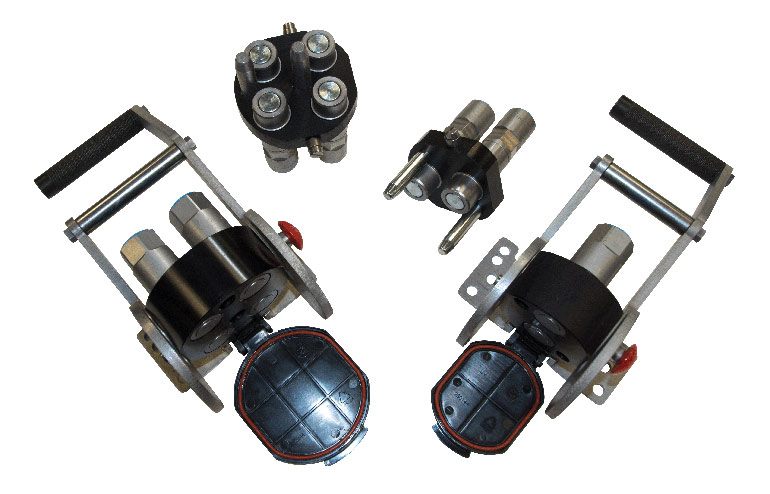Hydraulic quick couplers are indispensable tools in various industries that rely on hydraulic systems. They play a crucial role in connecting and disconnecting hydraulic hoses and attachments swiftly and efficiently. These couplers provide a secure and leak-free connection, allowing for seamless fluid transfer in hydraulic systems.

Courtesy of Holmbury
Typically made of durable materials like steel or brass, hydraulic quick couplers consist of two mating halves: a male and a female coupler. The male coupler features a protruding nipple with a check valve to prevent leakage when disconnected. The female coupler has a corresponding socket with internal seals and locking mechanisms. When the two halves are brought together, they form a tight seal that prevents hydraulic fluid from escaping.
Also called quick-connects or quick disconnects, these fittings allow fluid to flow when the male and female sides are locked together. Conversely, when disconnected, the quick couplings prevent fluid leakage using check valves to block exiting fluid.
One of the primary advantages of hydraulic quick couplers is their ability to connect and disconnect hydraulic components rapidly, saving valuable time during equipment setup or maintenance. They eliminate the need for time-consuming and messy manual threading or wrenching. With a simple push or pull action, the couplers securely lock into place, ensuring a reliable connection.
Moreover, hydraulic quick couplers enhance safety by minimizing the risk of fluid spills and leaks. The design of the couplers prevents accidental disconnection during operation, reducing the likelihood of injuries and damage to equipment.
The two most common types are the agricultural (pioneer) and flat face. The agricultural coupler uses two check balls that open to allow oil flow when pushed against each other when the couplers are connected. The flat face couplers use flat poppets that push inside one another, and offer superior contamination resistance, as the agricultural type can trap dirt. The threaded coupler is a third, less common option for specialty applications, such as trucking and high-pressure work tools. They employ male threads on the nipple portion, and when inserted and tightened into the female coupler, squeeze together to open both check valves. Thread-to-connect couplers offer a very high-pressure rating while offering very little flow in return.
Quick couplings should be sized based on their flow capacity. It’s a mistake to size couplings relative to the thread size on the hose or fitting to which the coupling attaches. For example, 3/8 in. quick couplings may only flow 4 gpm at 20 psi of backpressure, while the hose itself may flow double that amount.
It’s perfectly okay to use bushings to reduce the larger thread on the coupler down to the size of your plumbing. If your hose thread is larger than your coupling thread, your coupling is likely undersized.
Flat face couplers offer a more significant flow path with reduced pressure drop. Their interlocking sleeves open an extensive cross-section than poppet-style couplings. The poppets or ball-checks of the latter interfere with the flow path, creating pressure drop.
Just like many (but not all) hydraulic components, you get what you pay for. A set of ball-check couplings purchased from a local tractor parts store will offer little in common with the premium flat face couplers.
Inexpensive couplings will corrode more quickly, which is a problem with mobile applications. As previously mentioned, the flow rate will suffer using ball-check couplings, forcing you to oversize the set and pay more regardless. Cheap couplings will also leak more readily, all the while offering little in the way of smooth connection and disconnection. Finally, the poppet style loses oil every time you disconnect it and is also prone to collecting contamination in the female end’s open face.

Image courtesy of Holmbury
Premium flat face couplings offer corrosion-resistant parts that are precision-machined to offer the smoothest, most reliable connection. As discussed, their large flow path offers lower pressure drop, so you benefit from using a more appropriately sized set. Finally, most flat face couplings offer a twist lock that prevents accidental disconnection should an object hit the sleeve.
Multiplate couplers let users simultaneously connect and disconnect multiple hydraulic lines that contain residual pressure. This reduces operator error and improves KPIs (key performance indicators), saving companies time and money in the field.
Filed Under: Components Oil Coolers, Couplings & Fittings, Engineering Basics, Hose Assembly Tips